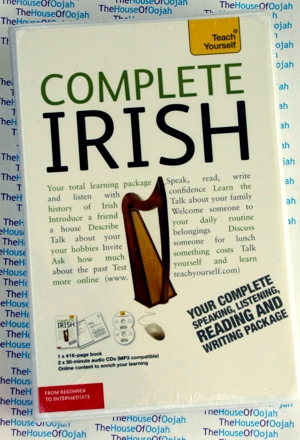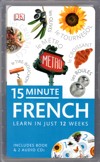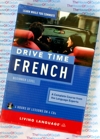Teach Yourself Complete Irish - Book and 2 Audio CDs - Learn to speak Irish

Teach Yourself Complete IrishBook and 2 Audio CDsGet Other Irish Audio Language learning Audio click here |
 |
Teach Yourself Complete Irish - Book and 2 Audio CDsBook and 2 Audio CDs Are you looking for a complete course in Irish which takes you effortlessly from beginner to confident speaker? Whether you are starting from scratch, or are just out of practice, Complete Irish will guarantee success! Now fully updated to make your language learning experience fun and interactive. You can still rely on the benefits of a top language teacher and our years of teaching experience, but now with added learning features within the course and online. The course is structured in thematic units and the emphasis is placed on communication, so that you effortlessly progress from introducing yourself and dealing with everyday situations, to using the phone and talking about work. By the end of this course, you will be at Level B2 of the Common European Framework for Languages: Can interact with a degree of fluency and spontaneity that makes regular interaction with native speakers quite possible without strain for either party. Learn effortlessly with a new easy-to-read page design and interactive features: NOT GOT MUCH TIME? AUTHOR INSIGHTS GRAMMAR TIPS USEFUL VOCABULARY DIALOGUES PRONUNCIATION TEST YOURSELF EXTEND YOUR KNOWLEDGE TRY THIS Comprehensive - gives you all you need to understand and speak basic, everyday Irish Table of Contents: About the Author:
About the Irish LanguageIrish , also known as Irish Gaelic, is a Goidelic language of the Indo-European language family, originating in Ireland and historically spoken by the Irish people. Irish is now spoken natively by a small minority of the Irish population – mostly in Gaeltacht areas – but also plays an important symbolic role in the life of the Irish state, and is used across the country in a variety of media, personal contexts and social situations. It enjoys constitutional status as the national and first official language of the Republic of Ireland and it is an official language of the European Union. Irish is also an officially recognised minority language in Northern Ireland. Irish is the main community and household language of 3% of the Republic's population Estimates of fully native speakers range from under 20,000 up to 80,000 people. The Department of Community, Rural and Gaeltacht Affairs estimated in 2007 that about 17,000 people lived in strongly Irish-speaking communities, about 10,000 people lived in areas where there was substantial use of the language, and 17,000 people lived in "weak" Gaeltacht communities; Irish was no longer the main community language in the remaining parts of the official Gaeltacht. However, since Irish is an obligatory subject in schools, many more are reasonably fluent second-language speakers. Furthermore, a much larger number regard themselves as competent in the language to some degree: 1,656,790 (41.9% of the total population aged three years and over) regard themselves as competent Irish speakers. On 13 June 2005, EU foreign ministers unanimously decided to make Irish an official language of the European Union. The new arrangements came into effect on 1 January 2007, and Irish was first used at a meeting of the EU Council of Ministers, by Minister Noel Treacy, T.D., on 22 January 2007. Many English-speaking Irish people use small and simple phrases (known as cúpla focal, "a few words") in their everyday speech, e.g. Slán ("goodbye"), Slán abhaile ("get home safely"), Sláinte ("good health"; used when drinking like "bottoms up" or "cheers"), Go raibh maith agat ("thank you"), Céad míle fáilte ("a hundred thousand welcomes", a tourist board saying, also used by President Hillery to welcome Pope John Paul II to Ireland in 1979) and Conas atá tú? ("How are you?"). There are many more small sayings that have crept into Hiberno-English. The term craic has been popularised outside Ireland in this Gaelicized spelling: "How's the craic?" or "What's the craic'?" ("how's the fun?"/"how is it going?"), though the word is not Irish in origin, and the expression "How's the crack?" was widely used in Ireland since at least the 1960s before the Irish-language spelling "craic" became the common journalistic style. Many public bodies have Irish language or bilingual names, but some have downgraded the language. An Post, the Republic's postal service, displays Irish place names in both Irish and English is equal prominence outside its offices and continues to have place names in Irish on its postmarks as well as recognising addresses (as does the Royal Mail in Northern Ireland). Traditionally, the private sector has been less supportive, although support for the language has come from some private companies. For example, Irish supermarket chain Superquinn introduced bilingual signs in its stores in the 1980s, a move which was followed more recently by the British chain Tesco for its stores in the Republic. Woodies DIY now also have bilingual signs in their chain of stores. In contrast, the "100% Irish" SuperValu has few if any Irish signs, and the German retailers Aldi and Lidl have none at all. In an effort to increase the use of the Irish language by the State, the Official Languages Act was passed in 2003. This act ensures that most publications made by a governmental body must be published in both official languages, Irish and English. In addition, the office of Language Commissioner has been set up to act as an ombudsman with regard to equal treatment for both languages. A major factor in the decline of natively-spoken Irish has been the movement of English speakers into the Gaeltacht (predominantly Irish speaking areas) and the return of native Irish-speakers who have returned with English-speaking partners. This has been stimulated by government grants and infrastructure projects: "only about half Gaeltacht children learn Irish in the home... this is related to the high level of in-migration and return migration which has accompanied the economic restructuring of the Gaeltacht in recent decades". In a last-ditch effort to stop the demise of Irish-speaking in Connemara in Galway, planning controls have been introduced on the building of new homes in Irish speaking areas. Thanks in large part to Gael-Taca and Gaillimh Le Gaeilge and two local groups a significant number of new residential developments are named in Irish today in most of the Republic of Ireland. In several counties there are a large number being named in Irish. |
Teach Yourself Complete Irish - Book and 2 Audio CDs |

 0 Items (Empty)
0 Items (Empty)



